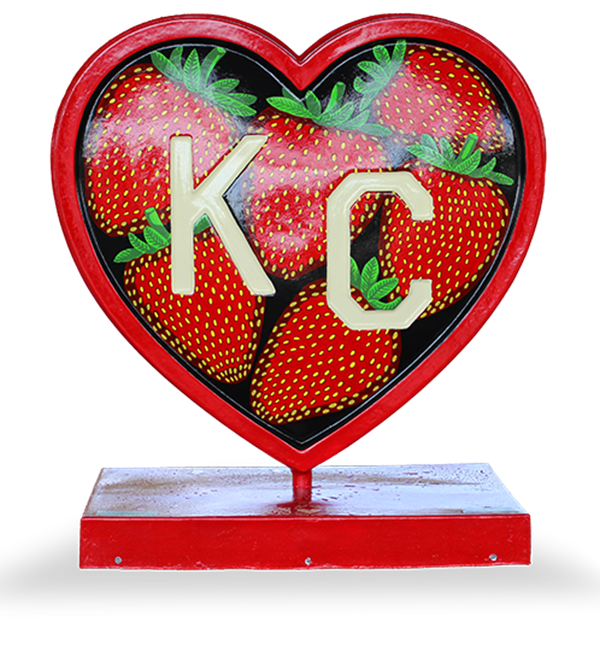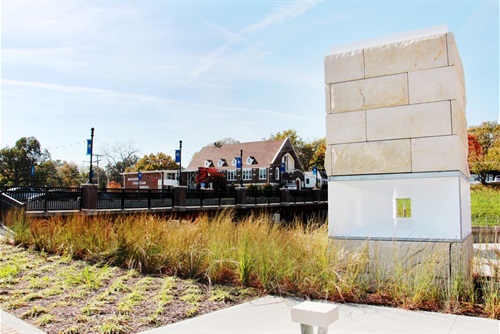Public Art
Merriam offers imaginative and inspirational art around every corner. Merriam City Council first established a five-year placemaking initiative in 2014. This public art program was designed to enhance public spaces around Merriam. Years later, Merriam is now home to many beautiful sculptures that visitors and residents can enjoy.
Merriam Celebrates New Public Art Installation at Community Center
The City of Merriam celebrated the unveiling of two new public art installations at the Merriam Community Center on Friday. Mayor Bob Pape joined artists from the Milagros Collective, along with representatives from Merriam Parks and Recreation and the Merriam Public Art Committee, for a ribbon-cutting ceremony marking the city’s latest addition to its growing public art collection.
Read More
Hearts Across Merriam
To celebrate Merriam's 75th birthday, local artist Dierk Van Keppel with Rock Cottage Glassworks has crafted 75 beautiful, custom-blown glass hearts, each unique and full of character. From January through October, we’ll hide these hearts in various public spaces across Merriam, encouraging residents and visitors to explore the city’s parks, landmarks, and trails in a fun and engaging way.
Each month, a new batch of hearts will be tucked away, waiting to be found. If you stumble upon one of these treasures, take a moment to snap a photo and share it on Facebook or Instagram. Be sure to tag @exploremerriam and use the hashtag #HeartsAcrossMerriam to show off your discovery and share what you love about Merriam. Then, you’re welcome to take the heart with you as a keepsake.
This initiative not only highlights the creativity of local talent but also inspires people to discover the beauty and charm of Merriam. From hidden corners of parks to unexpected city landmarks, the hunt for these handcrafted hearts will take you on a journey to appreciate Merriam’s landscape, history, and artistic spirit.
Join the heart-hunt adventure, share your finds, and be a part of Merriam’s 75th birthday activities year-round!
This program is sponsored by Merriam's Public Art Committee.
Public Art Master Plan
The new Public Art and Placemaking Master Plan contains a series of guidelines and recommendations that will assist the City in implementing a successful public art program. The goals of the plan are to foster place-based pride, rejuvenate and enliven public spaces, and create a more engaged community through public art.
To achieve the goals, the plan recommends all future projects be linked to specific placemaking outcomes, and defines public art in a more expansive way, inclusive of literature, performance, events, and experimental works in addition to visual arts. Public art is self-expression in any media that is created for the benefit of the general public.
These outcomes fall into three categories: creative placemaking, or outcomes relating to geographical locations and their qualities; community development, or outcomes relating to people and their needs; and economic development, or outcomes relating to financial growth and prosperity.
The plan also sets priorities for implementation, includes preferences on what type of art the community would like to see, where future art project could go, and recommends guidelines for the process of future art procurement.
Merriam Public Art and Placemaking Master Plan(PDF, 21MB)
Master Plan - At a Glance(PDF, 583KB)
Merriam's Public Art

Bask
2020
Artist: Blessing Hancock
Merriam Community Center, 6040 Slater Street
The newest of Merriam's public art pieces, Bask is located in the courtyard of the Merriam Community Center. Using the sun and pools as inspiration, the artist created this series as it relates to the surrounding environment and community activities. The sculptures incorporate words collected from Merriam residents describing their community. The sculpture comes alive with color-changing lighting at night.

Downtown Merriam Mural
2000
Artist: Michael Young
Merriam Community Center, 6040 Slater Street
This mural by Michael Young shows a replica of downtown Merriam, circa 1940. The stylized image was painted from a photo taken by Dr. Fawks who had family ties to Merriam for over 50 years. The mural was commissioned by the Merriam Community Center Foundation and funded by a grant from the Kansas City 150th Anniversary Legacy Fund.

Celebration
2021
Artist: Michael Walsh
Merriam Community Center, 6040 Slater St.
This piece was inspired by Flags 4 Freedom. It was commissioned by former Merriam City Councilmember Nancy Hupp in memory of her husband, Ron.
2025
Artist: Milagros Collective
Merriam Community Center Parking Structure, 6040 Slater St.
The interior staircase design draws inspiration from native Merriam plant life, illustrating a pattern of growth that ascends up the stairs. The top of the walls feature sculptural papercrete elements that form intricate, multicolored bursts of color – hand-painted with the help of community members. Vinyl patterns applied to the windows interact with natural light, adding depth, dimensionality, and a sense of movement to the overall piece. The title Grow Together reflects the spirit of this Merriam gathering place – a space where creativity and community thrive.

Hmmm...
2019
Artist: Joshua Weiner
Waterfall Park, 5191 Merriam Drive
This sculpture features a nine-foot tall caterpillar standing next to a 12-foot cairn (stack of river boulders) with a butterfly perched on top. This fun art piece was created to playfully explore placemaking and identity and is located at Merriam's beautiful Waterfall Park.

Motherhood
2006
Artist: Kwan Wu
Merriam Historic Plaza, 6304 E. Frontage Road
This bronze sculpture and water fountain was dedicated in 2006 at the Merriam Historic Plaza & Visitors Bureau. The mother bear with her cubs celebrate one of the most popular features of historic Merriam Park, a 40-acre amusement park greeting thousands of visitors daily in the late 1800s.
My Heart Resides in Strawberry Hill
2024
Artist: Kate E. Burke
Merriam Marketplace, 5740 Merriam Drive
With both sides covered in strawberries, it’s only fitting that this heart resides at the Merriam Farmers’ Market!
Artist Kate E. Burke said this piece honors the Strawberry Hill neighborhood with the image of ripe strawberries packed inside the heart.
“There is a thriving and engaging art scene growing in the Strawberry Hill neighborhood,” Burke said. “Along the edge and bottom is a nod to the Croatian immigrants who began settling this neighborhood back in the early 1900s.”
Burke said the embroidery pattern is inspired by the Croatian style of embroidery found on period folk clothing.

Planting the Seeds
2017
Artist: Christopher Weed
Merriam Marketplace, 5740 Merriam Drive
This stunning sculpture was inspired by nature. Each sphere's brilliant mirror finish with organic variations suggests a large, sprouting seed. The piece transforms the viewer to another realm – muting the outside distractions while providing an opportunity of reflection.

"Seasons of Historic Merriam" Mural
1986
Artist: Charles Goslin
Merriam City Hall, 9001 W. 62nd Street
This mural hangs in the Community Training Room at Merriam City Hall. It depicts people and events that shaped the early community of Campbelltown/Merriam. Native American tribes settled in the Turkey Creek basin when territories and reservations were established by the federal government. Covered wagons traveled the Santa Fe, California, and Oregon Trails through the area.
David Gee Campbell and former slave Cornelius Jackson are depicted with a bushel of apples. Campbell planted orchards through the area. On October 17, 1862, Quantrill sacked Shawnee Town in retaliation of atrocities by General Lane. Shortly after, Mr. Campbell constructed a home just west of Johnson Driec and Merriam Drive. It burned in 1881, one year after Campbell's untimely death in a railroad accident. It ws reconstructed on the same native stone foundation and still stands today. Merriam Park and the surrounding residential plats matured in the late 19th century. By 1907 the new Rosedale-Hocker Trolley line advertised service "just 35 minutes from Union Station by electric railroad." Service lasted until 1934.
2025
Artist: Milagros Collective
Merriam Community Center Parking Structure, 6040 Slater St.
The exterior staircase design feature shapes inspired by leaves and seeds, with colors flowing from the warm hues of autumn to the vibrant greens of spring, highlighting the changing seasons. The wall next to the stairs is painted in varying shades of blue, blending seamlessly with the sky. This thoughtful design encourages pedestrian engagement and serves as a reminder to appreciate the present moment, as the seasons are always in motion.

Still Time
2016
Artist: Dan Maginn, DRAW Architecture + Urban Design
Northwest corner of Johnson & Merriam Drives
This sculpture features an 8-foot limestone and steel tower with a large wind chime inside. The wind chime sounds counterpoint the busy intersection with a sense of calm. The work celebrates the timeless presence of wind on the site, tying into the memory of the original settlers of the region, the Kanza Tribe, which were known as the “People of the South Wind.” The artist team worked closely with UMKC composer Paul Rudy on the sound component of the piece. Once the tower was in place, the team performed an analysis of the resonance of the chamber, which allowed Paul to suggest the five exact notes that would resonate the most, and provide the richest sound experience.
More Art Around Merriam
Find murals and more art around Merriam on ExploreMerrriam.com!